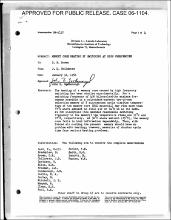| dc.contributor.author | Childress, J. D. | en_US |
| dc.date.accessioned | 2009-06-15T20:31:55Z | |
| dc.date.available | 2009-06-15T20:31:55Z | |
| dc.date.issued | 1956-01-31 | en_US |
| dc.identifier | MC665_r16_M-4137 | en_US |
| dc.identifier.uri | http://hdl.handle.net/1721.3/40632 | |
| dc.description | Includes: introduction, experimental procedure, discussion, conclusions, and charts. | en_US |
| dc.description.abstract | The heating of a memory core caused by high frequency
switching has been studied experimentally. For a
switching frequency of 4OO kilocycles (the maximum frequency possible in a coincident-current two-to-one
selection memory of 5 microsecond cycle time) the temperature of the memory core (DCL material) may rise more than 57 C above ambient in still air or 34 C in an oil bath.
At 200 kilocycles (the maximum reasonable switching frequency in the memory) the temperature rises are 33 C and 22 C, respectively. At 30 C above ambient (25 C), the memory
core fails to hold information dependably. Thus, with
forced air cooling the present memory should have no
problem with heating; however, memories of shorter cycle
time face serious heating problems. | en_US |
| dc.language.iso | en | en_US |
| dc.publisher | Lincoln Laboratory - Division 6 | en_US |
| dc.relation.ispartofseries | Division 6 Memo M-4137 | en_US |
| dc.relation.ispartofseries | Project Whirlwind Collection, MC665 | en_US |
| dc.subject.other | memory scheme | en_US |
| dc.subject.other | switching frequency | en_US |
| dc.title | Memory core heating by switching at high frequencies | en_US |
| dc.type | Technical Report | en_US |
